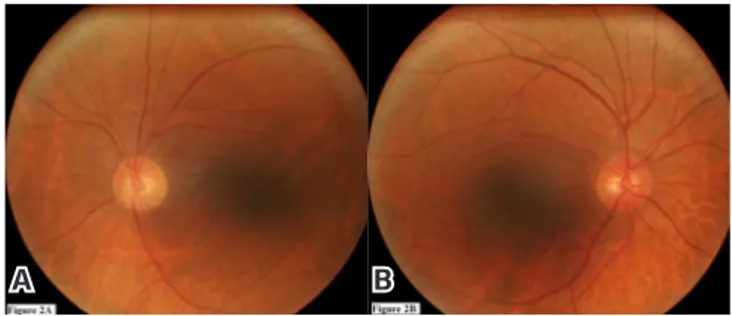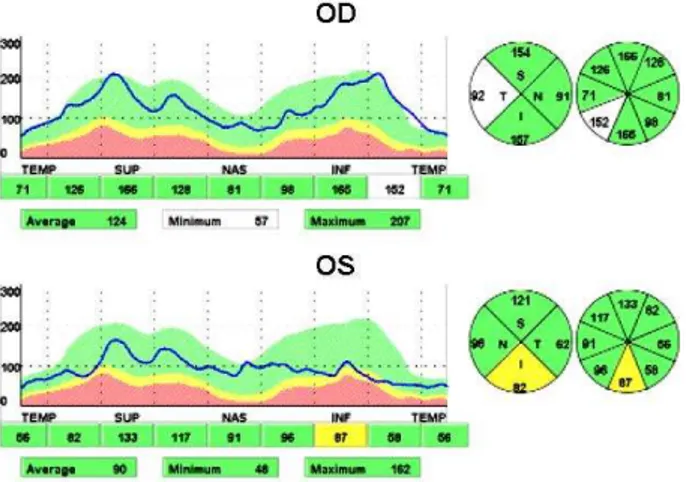Ischemic Changes in Pseudoexfoliation Syndrome
Ischemic Changes in a Case of
Unilateral Pseudoexfoliation Syndrome
Tek Taralı Psödoeksfoliasyon
Sendromlu bir Olguda İskemik Değişiklikler
DOI: 10.4328/JCAM.1698 Received: 26.02.2013 Accepted: 13.03.2013 Printed: 01.04.2016 J Clin Anal Med 2016;7(suppl 2): 87-9 Corresponding Author: Tolga Kocatürk, Department of Ophthalmology, Adnan Menderes University Medical School, 09010 Aydin, Turkey.
T.: +90 2564441256 GSM: +905333444111 E-Mail: tolgakocaturk@yahoo.com Özet
66 yaşında, glokomatöz görme alanı kayıplarını taklit eden, normotansif, tek ta
-ralı psödoeksfoliasyon sendromlu bir erkek hasta sunulmaktadır. Hastada, tek ta
-ralı belirgin iskeminin eşlik ettiği retinal sinir lifi tabakasında incelme ve ardışık görme alanlarında nazal adım defektleri vardı. Klinik olarak psödoeksfoliasyonun görüldüğü sol gözde, optik disk görünümü glokomatöz çukurlaşmayı desteklemese de; sağ göze göre daha soluk ve retinal damarlar daralmış görünümdeydi. Sol of
-talmik arterin renkli Doppler görüntülemesinde, rezistivite indeksinin 0.88 gibi ol
-dukça yüksek bir değerde olduğu görüldü. Olgu, psödoeksfoliasyonun oküler iske
-minin bir sebebi olduğunu belirten yeni literatür bilgileri ışığında tartışıldı.
Anahtar Kelimeler
Psödoeksfoliasyon Sendromu; Renkli Doppler; Retina; Sinir Lifi Tabakası; İskemi
Abstract
A 66 year old man with normotensive unilateral pseudoexfoliation syndrome
as-sociated with ipsilateral marked ischemia with nerve iber layer thinning and nasal step on successive visual ield tests mimicking glaucomatous visual ield loss is presented. Although the optic disc appearance of the clinically visible pseudoex
-foliative let eye was not suggestive of glaucomatous cupping the disc appeared
much pale and retinal vessels narrowed compared to the right eye. Color Doppler
imaging of the let ophthalmic artery showed extremely high resistivity index of
0.88. The case is discussed in light of recent literature underscoring the fact that pseudoexfoliation is a cause of ocular ischemia.
Keywords
Pseudoexfoliation Syndrome; Color Doppler; Retina; Nerve Fiber Layer; Ischemia
Tolga Kocaturk1, Isıl Isıklıgil1, Volkan Dayanir1, Yelda Ozsunar2, Harun Cakmak1 1Department of Ophthalmology, 2Department of Radiology, Adnan Menderes University Medical School, Aydin, Turkey
Introduction
Pseudoexfoliation syndrome (PXS) is the most common identii-able cause of open angle glaucoma worldwide [1]. Pseudoex-foliative material on the walls of iris vessels, posterior ciliary arteries, vortex veins, and central retinal vessels [2] may alter blood low parameters by causing several types of vascular damage [2,3].
Accumulation of pseudoexfoliative material in iridial vessel walls is associated with increased permeability, narrowing, and inally obstruction [2]. Increased ophthalmic artery resistivity in-dex (RI) in pseudoxfoliation have been reported by two indepen-dent studies [4,5]. Saatçi et al. found presence of pseudoexfolia-tive material as a likely risk factor for retinal vein occlusion [6]. Puska et al. observed optic disc changes in the afected eyes of unilateral PXS patients over time and concludes that the pseu-doexfoliative process itself may be a risk factor for optic disc changes [7].
We here in describe a normotensive case of unilateral PXS with marked increase in RI of the ipsilateral ophthalmic artery and signiicant retinal vascular attenuation associated with optic disc pallor and a visual ield defect resembling nasal step in the let eye. To the best of our knowledge, this is the irst case of optic neuropathy associated with marked ischemia mimicking glaucomatous visual ield loss in a patient having PXS.
Case Report
A 66 year old man presented to our outpatient clinic with a chief complaint of itching, burning and stinging in both eyes. He had no prior medical history of diabetes mellitus, hypertension or family history of glaucoma. He was not using any chronic topi-cal or oral medication. Best corrected visual acuities were 0.00 logMAR equivalent with +1.00 D refraction in the right, and 0.10 logMAR equivalent with +1.00 (+0.25x110) refraction in the let eye. Intraocular pressures (IOP) measured with a non contact tonometer (Reichert, Xpert NCT Plus, Bufalo, NY) on the day of outpatient visit were 13 mmHg and 12 mmHg on the right and let eyes respectively. Biomicroscopic examination showed pseudoexfoliative material at the pupil margin of the let eye. Dilated fundus examination showed cup-to-disc ratio to be 0.35 and 0.3 in the right and let eyes respectively, there were no nerve iber layer defect or disc notching, and vertical disc size was 1.1 mm (as measured using a +78D lens) in both eyes. The patient was considered to be unilateral PXS and was planned to be recruited in a clinical study. Oice-hour IOPs were 15, 13, 12 mmHg, and 14, 13, 12 mmHg for the right, and let eyes respectively with Goldmann applanation tonometry. Cor-neal pachymetry (IOPac Advanced Pachymeter, Heidelberg En-gineering, StarFish, Victoria, BC, Canada, V8V 2T2) in the right, and let eyes were 541 ± 3.5 µm, and 554 ± 2.0 µm respec-tively. The visual ield test that was repeated three times within 4 months was normal for the right eye whereas the let eye consistently had a superior nasal step. The last follow-up visual ield had been done in 17th month follow-up (Figure 1).
Due to the superior nasal step visual ield defect observed in the let eye, the diagnosis of “unilateral PXS” was reconsidered and the patient had a second dilated fundus examination. Sig-niicant disc pallor especially prominent inferotemporally cor-responding to the superior nasal step visual ield defect as well
as decreased caliber and irregular contour of all retinal vessels were observed in the let eye compared to the right (Figure 2). Scanning laser polarimetry (GDx VCC, Carl Zeiss, USA) (Figure 3) and optical coherence tomography (OCT/SLO, Ophthalmic
Technologies Inc., Canada) (Figure 4) revealed thinned nerve i-ber layer in the let eye.
The subject had normal color vision with Ishihara plates and no relative aferent pupillary defect.
Brain and orbital magnetic resonance imaging (MRI) revealed non-speciic periventricular gliosis and mild thinning of the let
Figure 1. Let eye had a superior nasal step that was consistent in all visual ield tests and Glaucoma Progression Analysis of the last visual ield test showing no
progression
Figure 2. (A) Let fundus showing a c/d 0,3, pale optic disc and vessels of de
-creased caliber compared to the right eye. (B) Right fundus showing a c/d 0,35.
Figure 3. Scanning laser polarimetry of the let eye reveals thinning of the nerve iber layer inferiorly although it is within normal limits.
A
B
I Journal of Clinical and Analytical Medicine
88
optic nerve.
Color Doppler imaging of ophthalmic artery showed peak sys-tolic velocity (PSV) of 24.9 cm/s and 42.1 cm/s, end diassys-tolic velocity (EDV) of 7.2 cm/s and 5.0 cm/s, and RIs of 0.71 and 0.88 in the right and let eyes respectively.
Discussion
The RI is a comparison of the low in systole and diastole and provides an indication of the resistance in the peripheral vas-cular bed; it can be used to facilitate an evaluation of perfu-sion of an organ [8]. We have previously shown that in unilateral PXS, the afected side has signiicantly higher mean ophthal-mic artery RI (mean ± SD, 95% CI; 0.74 ± 0.04 cm/s, 0.72-0.75) compared to age-sex matched controls (0.69 ± 0.07 cm/s, 0.66-0.72; p=0.009) [5]. Similar results were obtained by Yüksel et al. [4] We have suggested a value of 0.72 for RI to be the cut-of value for diferentiation of PXS.
The case in discussion had a let ophthalmic artery RI of 0.88 which is far above what we had reported for the unilateral PXS [5]. We believe that the attenuated retinal vessels and pale op-tic disc seen on the let fundus are a relection of increased vascular resistance in the ophthalmic artery due to buildup of pseudoexfoliative material in vessel walls. The chronic ischemia might have led to progressive thinning of the nerve iber layer which might eventually lead to marked cupping of the optic disc. Indeed, presence of thinner retinal nerve iber layer has been shown in PXS when compared to the controls [9].
Repo et al. [10] suggested pathologic changes in the blood sup-ply of PXS eyes by showing strong correlations between PSX and patients who had had a transient ischemic attact with ab-normal iris transluminance.
We believe that the case described is an extreme example of normotensive ocular ischemia caused by pseudoexfoliation. Such cases are probably missed on clinical grounds since they are normotensive and are not given routine visual ields or other ancillary glaucoma tests. We suggest routine glaucoma work-up to all pseudoexfoliation patients regardless of their IOPs and use the ophthalmic artery RI of 0.72 as the cut-of value when evaluating increased vascular resistance for ophthalmic artery.
Competing interests
The authors declare that they have no competing interests.
References
1. Ritch R. The most common identiiable cause of open angle glaucoma.
J.Glaucoma 1994; 3:176-178.
2. Shimizu T. Changes of iris vessels in capsular glaucoma: three-dimensional and
electron microscopic studies. Jpn J Ophthalmol 1985;29:434-452.
3. Hollo G, Lakatos P, Farkas K. Cold pressor test and plasma endothelin-1 concen -tration in primary open- angle and capsular glaucoma. J Glaucoma 1998;7:105– 110.
4. Yüksel N, Karabaş VL, Arslan A, Demirci A, Cağlar Y. Ocular hemodynamics in
pseudoexfoliation syndrome and pseudoexfoliation glaucoma. Ophthalmology 2001;108:1043–1049.
5. Dayanir V, Topaloğlu A, Ozsunar Y, Keceli M, Okyay P, Harris A. Orbital blood low
parameters in unilateral pseudoexfoliation syndrome. Int Ophthalmol. 2008;29:27-32.
6. Saatci OA, Ferliel ST, Ferliel M, Kaynak S, Ergin MH. Pseudoexfoliation and glau -coma in eyes with retinal vein occlusion. International Ophthalmology 1999;23:75-78.
7. Puska P, Vesti E, Tomita G, Ishida K, Raitta C. Optic disc changes in normotensive persons with unilateral exfoliation syndrome: a 3-year follow-up study. Graefes Arch Clin Exp Ophthalmol 1999;237:457-462.
8. Meritt CRB. Physics of Ultrasound. In: Rumack CM, Wilson SR, Charboneau JW, Johnson JM, eds. Diagnostic Ultrasound. St Louis: Mosby Year Book; 2005: 3-34. 9. Gumus K, Bozkurt B, Sonmez B, Irkeç M, Orhan M, Saracbası O. Diurnal varia
-tion of intraocular pressure and its correla-tion with retinal nerve iber analysis in
Turkish patients with exfoliation syndrome. Graefe’s Arch Clin Exp Ophthalmol. 2006;244:170–176.
10. Repo LP, Suhonen MT, Terasvirta ME, Koivisto KJ. Color Doppler imaging of the ophthalmic artery blood low spectra of patients who have had a transient ischemic attack. Correlations with generalized iris transluminance and pseudoex -foliation syndrome. Ophthalmology 1995; 102:1199-1205.
How to cite this article:
Kocaturk T, Isıklıgil I, Dayanir V, Ozsunar Y, Cakmak H. Ischemic Changes in a Case
of Unilateral Pseudoexfoliation Syndrome. J Clin Anal Med 2016;7(suppl 2): 87-9.
Figure 4. Optical coherence tomography showed nerve iber layer thinning in the let eye.
Journal of Clinical and Analytical Medicine I 89

